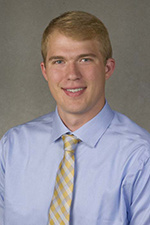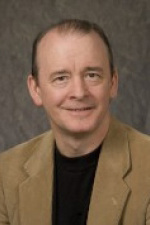Two University of Iowa physicists serve key roles in the future for fusion energy and plasma science in the United States.

Scott Baalrud, associate professor in the Department of Physics and Astronomy, co-chaired a committee that was charged with outlining a 10-year vision for fusion energy and plasma physics research. The committee’s report, completed in March, is being reviewed by the Fusion Energy Sciences Advisory Committee (FESAC), an advisory panel that will propose formal recommendations to the U.S. Department of Energy’s (DOE) Office of Fusion Energy Sciences. Fred Skiff, chair and professor in the Department of Physics and Astronomy, is a FESAC member.

“The ultimate outcome is we submit a report to FESAC and FESAC votes to approve it—our report would be the official advice to the Department of Energy,” Baalrud says. “It’s exciting to map out what the future could hold.”
Fusion is the nuclear reactions that power stars, including our sun. On Earth, creating this virtually limitless, carbon-free energy source would be a monumental achievement, but the means and materials to harness fusion energy have eluded scientists for decades.
Yet there is renewed vigor to pursue this goal. An international collaboration called ITER is working to build the world's largest tokamak, a magnetic fusion device that has been designed to prove whether it is indeed possible to create, and maintain, a an artificial fusion-energy source.
The committee that Baalrud co-chaired, affiliated with the American Physical Society, details in its report a plan to develop a pilot fusion plant in the U.S. in the 2040s.
“It identifies what the remaining technological and scientific challenges are and how we can address them in that time frame,” Baalrud says. “It means the fusion energy community wants to build a fusion energy plant, and those scientists want to fill in the gaps to make that possible in the next 10 to 20 years.”
“This is great for our reputation as a department and as a university. In the future, when we go to hire top talent in plasma physics, Iowa will be on the radar of the best candidates.”
—Fred Skiff, chair and professor in the Iowa Department of Physics and Astronomy
Baalrud says the main scientific barrier is understanding how burning plasma works, and creating an experiment that successfully produces burning plasma. On the technology side, Baalrud says, it’s getting the right materials to build a fusion reactor.
The report also addresses plasma physics, which is Baalrud’s research emphasis at Iowa.
Plasma physics is responsible for many technologies—from health care to the environment—that are important contributors to society. One example: integrated circuits, which are the backbone of many computers. Advances in plasma science research have led to the development of nanoscale-sized circuits—with wires just several atoms wide—that have significantly increased computers’ processing speed.
“There are exciting physics being done in plasma physics independent of fusion energy,” Baalrud says. “Planning what these could contribute to our society and our culture frankly is exciting to ponder.”
As committee co-chair, Baalrud occupied a front-row seat to the discussions around the next steps in plasma physics and fusion energy. He helped lead a workshop, held in Madison, Wisconsin, that convened various disciplines in the physics community “that don’t normally come together,” he says.
The result? “People really liked learning about what other people were doing outside their specialty,” Baalrud adds.
Skiff says Baalrud’s involvement on the committee has made him a leader in the strategic planning process for the DOE.
“This is great for our reputation as a department and as a university,” Skiff says. “In the future, when we go to hire top talent in plasma physics, Iowa will be on the radar of the best candidates.”
The committee’s report, “A Community Plan for Fusion Energy and Discovery Plasma Sciences,” is now being considered by a FESAC subcommittee. That body will decide which areas to move forward under three different budget scenarios and then present those recommendations to FESAC as a whole.
Skiff, as a FESAC member, will have an important voice in charting those directions.
“FESAC, as a congressional advisory committee, can give specific direction to the DOE on how to run its program in fusion energy and plasma physics,” Skiff says. “Sometimes it is easy to become jaded about people in government service, but my experience in Washington has been that we do have many dedicated public servants, and I am glad to have a chance to help them. For this task especially, we are serving the next generation.”